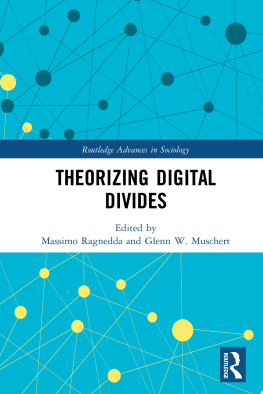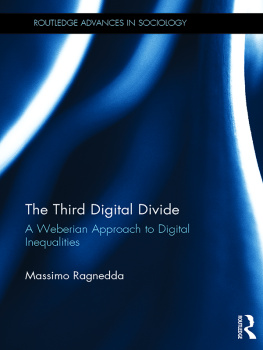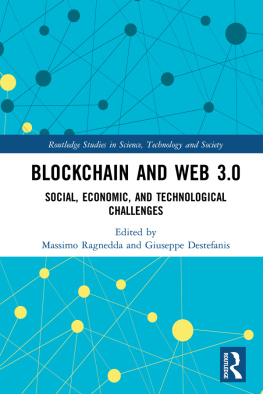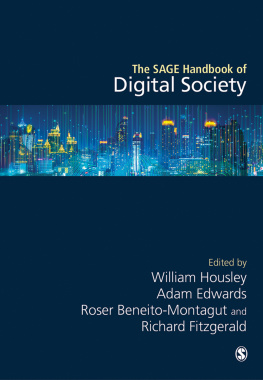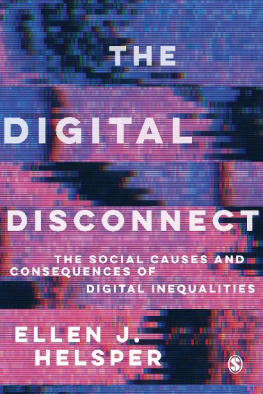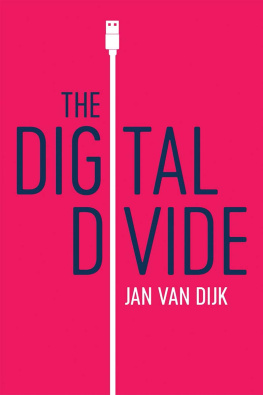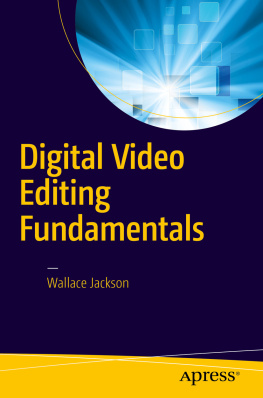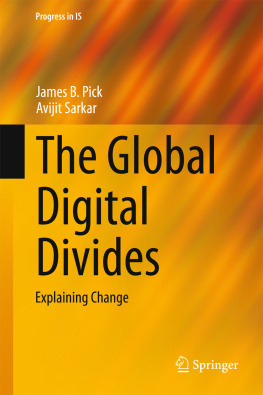Massimo Ragnedda - Theorizing Digital Divides
Here you can read online Massimo Ragnedda - Theorizing Digital Divides full text of the book (entire story) in english for free. Download pdf and epub, get meaning, cover and reviews about this ebook. year: 2017, publisher: Taylor & Francis (CAM), genre: Politics. Description of the work, (preface) as well as reviews are available. Best literature library LitArk.com created for fans of good reading and offers a wide selection of genres:
Romance novel
Science fiction
Adventure
Detective
Science
History
Home and family
Prose
Art
Politics
Computer
Non-fiction
Religion
Business
Children
Humor
Choose a favorite category and find really read worthwhile books. Enjoy immersion in the world of imagination, feel the emotions of the characters or learn something new for yourself, make an fascinating discovery.
- Book:Theorizing Digital Divides
- Author:
- Publisher:Taylor & Francis (CAM)
- Genre:
- Year:2017
- Rating:5 / 5
- Favourites:Add to favourites
- Your mark:
- 100
- 1
- 2
- 3
- 4
- 5
Theorizing Digital Divides: summary, description and annotation
We offer to read an annotation, description, summary or preface (depends on what the author of the book "Theorizing Digital Divides" wrote himself). If you haven't found the necessary information about the book — write in the comments, we will try to find it.
Theorizing Digital Divides — read online for free the complete book (whole text) full work
Below is the text of the book, divided by pages. System saving the place of the last page read, allows you to conveniently read the book "Theorizing Digital Divides" online for free, without having to search again every time where you left off. Put a bookmark, and you can go to the page where you finished reading at any time.
Font size:
Interval:
Bookmark:

Theorizing Digital Divides
Although discussion of the digital divide is a relatively new phenomenon, social inequality is a deeply entrenched part of our current social world and is now reproduced in the digital sphere. Such inequalities have been described in multiple traditions of social thought and theoretical approaches. To move forward to a greater understanding of the nuanced dynamics of digital inequality, we need the theoretical lenses to interpret the meaning of what has been observed as digital inequality.
This volume examines and explains the phenomenon of digital divides and digital inequalities from a theoretical perspective. Indeed, with there being a limited amount of theoretical research on the digital divide so far, Theorizing Digital Divides seeks to collect and analyse different perspectives and theoretical approaches in analysing digital inequalities, and thus propose a nuanced approach to study the digital divide.
Exploring theories from diverse perspectives within the social sciences whilst presenting clear examples of how each theory is applied in digital divide research, this book will appeal to scholars and undergraduate and postgraduate students interested in sociology of inequality, digital culture, Internet studies, mass communication, social theory, sociology, and media studies.
Massimo Ragnedda is a Senior Lecturer in Mass Communication at Northumbria University, Newcastle.
Glenn W. Muschert is a Professor of Sociology and Social Justice Studies at Miami University, Ohio.
Routledge Advances in Sociology
For a full list of titles in this series, please visit www.routledge.com/series/SE0511
New Immigration Destinations
Migrating to Rural and Peripheral Areas
Ruth McAreavey
Open Borders, Unlocked Cultures
Romanian Roma Migrants in Western Europe
Edited by Yaron Matras and Daniele Viktor Leggio
Digital Music Distribution
The Sociology of Online Music Streams
Hendrik Storstein Spilker
Liberalism 2.0 and the Rise of China
Global Crisis and Innovation
David Tyfield
The Quantified Self in Precarity
Work, Technology and What Counts
Phoebe Moore
Theorizing Digital Divides
Massimo Ragnedda and Glenn W. Muschert
Child Figures, Literature, and Science
Fragile Subjects
Edited by Jutta Ahlbeck, Pivi Lappalainen, Kati Launis and Kirsi Tuohela
Mass Shootings in Comparative Perspective
Communities and Shared Experiences in the Aftermath
Johanna Nurmi
Mega-Events as Economies of the Imagination
Creating Atmospheres for Rio 2016 and Tokyo 2020
Rodanthi Tzanelli
Theorizing Digital Divides
Edited by Massimo Ragnedda and Glenn W. Muschert

First published 2018
by Routledge
2 Park Square, Milton Park, Abingdon, Oxon OX14 4RN
and by Routledge
711 Third Avenue, New York, NY 10017
Routledge is an imprint of the Taylor & Francis Group, an informa business
2018 selection and editorial matter, Massimo Ragnedda and Glenn W. Muschert; individual chapters, the contributors
The right of Massimo Ragnedda and Glenn W. Muschert to be identified as the authors of the editorial material, and of the authors for their individual chapters, has been asserted in accordance with sections 77 and 78 of the Copyright, Designs and Patents Act 1988.
All rights reserved. No part of this book may be reprinted or reproduced or utilised in any form or by any electronic, mechanical, or other means, now known or hereafter invented, including photocopying and recording, or in any information storage or retrieval system, without permission in writing from the publishers.
Trademark notice : Product or corporate names may be trademarks or registered trademarks, and are used only for identification and explanation without intent to infringe.
British Library Cataloguing in Publication Data
A catalogue record for this book is available from the British Library
Library of Congress Cataloging in Publication Data
[CIP data]
ISBN: 978-1-138-21040-0 (hbk)
ISBN: 978-1-315-45533-4 (ebk)
Typeset in Times New Roman
by Deanta Global Publishing Services, Chennai, India
Contents
MASSIMO RAGNEDA AND GLENN MUSCHERT
GLENN W. MUSCHERT AND RYAN GUNDERSON
MASSIMO RAGNEDDA AND MARIA LAURA RUIU
TOMOHISA HIRATA
BARBARA BARBOSA NEVES AND GEOFFREY MEAD
GERARD GOGGIN
LORENZO DALVIT
SUSAN B. KRETCHMER
JOHN HAFFNER
EVA KLINKISCH AND ANNE SUPHAN
LAST MOYO
DUYGU ZSOY
CIT WILLIAMS, TANIA GUPTA AND MARILYN WALLACE
MORTEN HJELHOLT AND JANNICK SCHOU
EMMA JANE
JAN VAN DIJK
Massimo Ragnedda and Glenn Muschert
The core analysis in this book is to examine and explain the phenomena of digital divide and digital inequalities from a theoretical perspective. Indeed, only a small amount of theoretical research on digital divide has been carried out so far. Theorizing digital divide fills this gap by collecting different perspectives and theoretical approaches in analysing digital inequalities, and by proposing a more nuanced approach to study the digital divide. This book proposes some well-known theories (i.e. Weber, Bourdieu and Simmel) as well as hitherto untouched theoretical visions (i.e. neo-colonialism, recognitional perspective and non-western perspective) to explain this contemporary phenomenon. Theorizing digital divide brings together innovative work from a wide range of contexts and traditions which explicitly focus on the roles of theory in digital divide research. The book includes contextual and socio-historical analyses of existing traditions of theory and theorizing, exemplary use of theory and empirical work where theory has been used in innovative ways. Theorizing digital divide develops a very different standpoint. Each chapter takes core social theories and explains digital divide from a specific theoretical lens. In so doing authors offer several angles from which to look at the complexity of the phenomenon of digital divide. Indeed, although digital divide is a relatively new phenomenon (one of the first attempts to define it comes from Bill Clinton and Al Gore in 1996), the inequalities (now reproduced in the digital sphere) are a deeply entrenched part of our current social world. Such inequalities have been described in multiple traditions of social thought and theoretical approaches. We cannot really understand the digital divide without seeing the broader picture in which we digitally engage. To understand such a picture we need the theoretical lens through which to give a meaning to the reality and transform observation to conceptualization. For this reason, we have invited scholars from different disciplines (Internet studies, sociology and media studies) to apply different theoretical approaches to provide a fresh perspective on the rise and persistence of digital and social inequalities.
As part of the MeCCSA (Media, Communication and Cultural Studies Association) conference 2015, the editors proposed a special track, namely Theorizing digital divide, in order to discuss, from a theoretical point of view, the phenomenon of the digital divide. We received forty-eight abstracts and selected eighteen of them for a total of four panels. It was exactly at the time that the idea of this book arose, following the useful discussion that that conference had generated. Indeed, for a couple of days authors have discussed with colleagues the importance and necessity of an overall book that included different theoretical approaches. In order to expand the theoretical perspectives brought to bear on social relations in digital spheres, we have invited scholars from different disciplines to apply social theories of stratification, inequalities, postmodernity, feminism, Marxism, etc., to develop new perspectives on the rise and persistence of digital inequalities. The idea, when we launched the call, was to bring together, in an edited volume, a variety of statements from scholars around the world, in which social theories are central to the discussion of digital divides. Thus, the core analysis in this edited collection is to examine and explain the phenomenon of digital divide from a broad range of theoretical perspectives. It presents theoretical frameworks generated by research from many disciplines, including sociology, psychology, political science, organizational studies and media studies. The idea beyond this collection of theoretical chapters is to stimulate innovative ways to study digital and social inequalities in digitally enabled networked societies. The theoretical approaches used to analyse the rise and persistence of digital divide have moved beyond the simple access to the Internet (first level of digital divide). Indeed, once we narrow down the gap in terms of access, new and more sophisticated issues arise, such as inequalities in use, skills, motivation and purpose of uses (second level of digital divide). Furthermore, new forms of inequalities arise in terms of opportunities and possibilities to improve ones life chances by reinvesting in the social realm resources and knowledge acquired online. This is what could be defined as the third level of digital divide (Ragnedda, 2017). Indeed, one of the core aspects of this book is that the phenomena of digital divide, digital inequalities and digital inclusion/exclusion are social phenomena, rather than simply technological or economic phenomena. Indeed, as more aspects of social life are migrating and expanding online, systems of structured inequalities are now well-entrenched and replicated in the digital sphere. These new forms of inequalities have consequences both in the digital and social sphere, and new theoretical approaches and models are needed in order to provide the frameworks able to explain how specific features of society are linked to larger processes. Despite the vital importance of theories in providing insight on such issues, the development of the theoretical aspect of digital divide studies has lagged behind the development of more empirical studies. Traditional studies of digital divides have tended to be macro in scope, and often convey a flavour of government reporting on infrastructure and electronic capacities. Of course, there are many exceptions among scholars working in a variety of fields, however, even given a variety of national and cultural perspectives from which such studies emerge, the theoretical underpinnings of such studies often proceed from a narrow range of perspectives. The narrow stretch of social theories thus far applied to digital divides is surprising, given the diversity of theoretical developments which have developed in social theories, especially in the last half century. By bringing together the variety of theoretical approaches emerging in the study of digital divide, this volume highlights novel ways of thinking about digital divide that encompass broader perspectives and offers alternative ways to approach this issue. Indeed, there is too much emphasis on the technological, empirical and economic aspects of the digital society, while there is a lack of social scientific analysis. The technological trajectories themselves are insufficient bases for analysis of the digital divide, and rather it is the forms of online participation and digital inclusion that are based on cultural and social protocols of social closure that need analysis. While access, control and ownership have been at the centre of the analysis of the digital divide and digital inequalities, this book argues that the discussion on social equality and digital inclusion/exclusion should also address the theoretical aspects that help in understanding and decoding this complex issue. Indeed, the digital divide is a multidimensional, highly sophisticated and stimulating issue, and a broad range of theoretical approaches are useful in determining general explanations of this social phenomenon. Theoretical models of the digital divide usually represent digital divide as the result of different steps from motivation to access, from skills to uses and opportunities (DiMaggio et al. , 2004). Although these frameworks propose a nuanced and deeper understanding of the digital divide, especially compared to the initial notion of haves and haves not, they often lack a holistic perspective and underestimate how the socio-cultural context shapes attitudes towards the Internet and its appropriation by the users. Along these lines, digital divide research has been criticized for oversimplifying the relationship between demographic characteristics and Internet use (Halford & Savage, 2010; Sims, 2014) and for its under-theorization (Van Dijk, 2006). This volume offers, from different theoretical angles, a holistic approach to digital divide, proposing several theoretical approaches to read and decode digital divide. This volume fills a gap in the literature by proposing a global perspective and including classic social theories as well as more contemporary approaches, and also under-studied theoretical approaches. These new perspectives offer a fresh overview to analyse the digital divide, often simply reduced as a matter of access or skills. Theorizing digital divide summarizes theories from such diverse perspectives while presenting clear examples of how these theories are applied in digital divide research. It presents in a single volume some of the best known schools of thought that have shaped the trajectory of social sciences studies and applied them to digital divide. This volume presents a comprehensive review and critique of the broad range of theoretical frameworks designed to explain the digital divide and its consequences in our daily life.
Font size:
Interval:
Bookmark:
Similar books «Theorizing Digital Divides»
Look at similar books to Theorizing Digital Divides. We have selected literature similar in name and meaning in the hope of providing readers with more options to find new, interesting, not yet read works.
Discussion, reviews of the book Theorizing Digital Divides and just readers' own opinions. Leave your comments, write what you think about the work, its meaning or the main characters. Specify what exactly you liked and what you didn't like, and why you think so.

